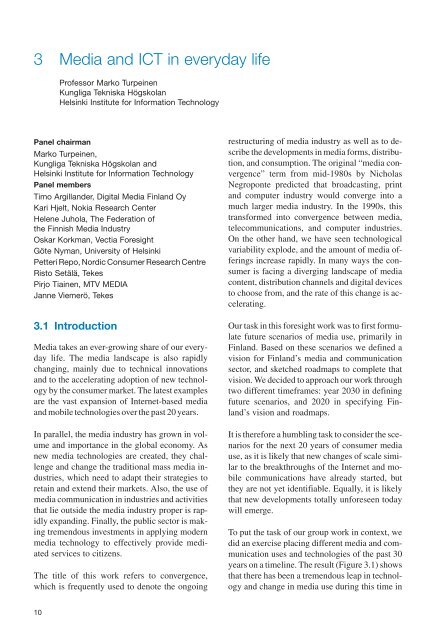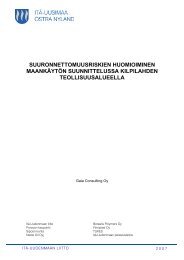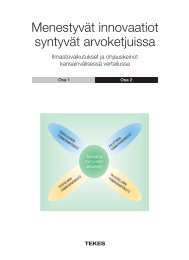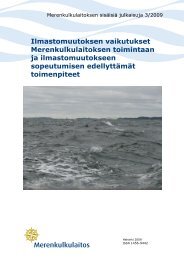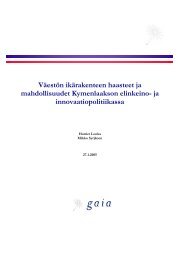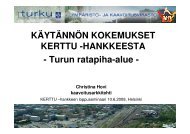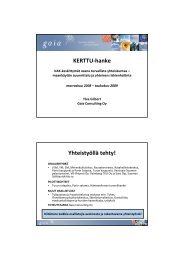227/08 Social challanges s the basis for foresight - Gaia
227/08 Social challanges s the basis for foresight - Gaia
227/08 Social challanges s the basis for foresight - Gaia
Create successful ePaper yourself
Turn your PDF publications into a flip-book with our unique Google optimized e-Paper software.
3 Media and ICT in everyday life<br />
Professor Marko Turpeinen<br />
Kungliga Tekniska Högskolan<br />
Helsinki Institute <strong>for</strong> In<strong>for</strong>mation Technology<br />
Panel chairman<br />
Marko Turpeinen,<br />
Kungliga Tekniska Högskolan and<br />
Helsinki Institute <strong>for</strong> In<strong>for</strong>mation Technology<br />
Panel members<br />
Timo Argillander, Digital Media Finland Oy<br />
Kari Hjelt, Nokia Research Center<br />
Helene Juhola, The Federation of<br />
<strong>the</strong> Finnish Media Industry<br />
Oskar Korkman, Vectia Foresight<br />
Göte Nyman, University of Helsinki<br />
Petteri Repo, Nordic Consumer Research Centre<br />
Risto Setälä, Tekes<br />
Pirjo Tiainen, MTV MEDIA<br />
Janne Viemerö, Tekes<br />
3.1 Introduction<br />
Media takes an ever-growing share of our everyday<br />
life. The media landscape is also rapidly<br />
changing, mainly due to technical innovations<br />
and to <strong>the</strong> accelerating adoption of new technology<br />
by <strong>the</strong> consumer market. The latest examples<br />
are <strong>the</strong> vast expansion of Internet-based media<br />
and mobile technologies over <strong>the</strong> past 20 years.<br />
In parallel, <strong>the</strong> media industry has grown in volume<br />
and importance in <strong>the</strong> global economy. As<br />
new media technologies are created, <strong>the</strong>y challenge<br />
and change <strong>the</strong> traditional mass media industries,<br />
which need to adapt <strong>the</strong>ir strategies to<br />
retain and extend <strong>the</strong>ir markets. Also, <strong>the</strong> use of<br />
media communication in industries and activities<br />
that lie outside <strong>the</strong> media industry proper is rapidly<br />
expanding. Finally, <strong>the</strong> public sector is making<br />
tremendous investments in applying modern<br />
media technology to effectively provide mediated<br />
services to citizens.<br />
The title of this work refers to convergence,<br />
which is frequently used to denote <strong>the</strong> ongoing<br />
10<br />
restructuring of media industry as well as to describe<br />
<strong>the</strong> developments in media <strong>for</strong>ms, distribution,<br />
and consumption. The original “media convergence”<br />
term from mid-1980s by Nicholas<br />
Negroponte predicted that broadcasting, print<br />
and computer industry would converge into a<br />
much larger media industry. In <strong>the</strong> 1990s, this<br />
trans<strong>for</strong>med into convergence between media,<br />
telecommunications, and computer industries.<br />
On <strong>the</strong> o<strong>the</strong>r hand, we have seen technological<br />
variability explode, and <strong>the</strong> amount of media offerings<br />
increase rapidly. In many ways <strong>the</strong> consumer<br />
is facing a diverging landscape of media<br />
content, distribution channels and digital devices<br />
to choose from, and <strong>the</strong> rate of this change is accelerating.<br />
Our task in this <strong>for</strong>esight work was to first <strong>for</strong>mulate<br />
future scenarios of media use, primarily in<br />
Finland. Based on <strong>the</strong>se scenarios we defined a<br />
vision <strong>for</strong> Finland’s media and communication<br />
sector, and sketched roadmaps to complete that<br />
vision. We decided to approach our work through<br />
two different timeframes: year 2030 in defining<br />
future scenarios, and 2020 in specifying Finland’s<br />
vision and roadmaps.<br />
It is <strong>the</strong>re<strong>for</strong>e a humbling task to consider <strong>the</strong> scenarios<br />
<strong>for</strong> <strong>the</strong> next 20 years of consumer media<br />
use, as it is likely that new changes of scale similar<br />
to <strong>the</strong> breakthroughs of <strong>the</strong> Internet and mobile<br />
communications have already started, but<br />
<strong>the</strong>y are not yet identifiable. Equally, it is likely<br />
that new developments totally un<strong>for</strong>eseen today<br />
will emerge.<br />
To put <strong>the</strong> task of our group work in context, we<br />
did an exercise placing different media and communication<br />
uses and technologies of <strong>the</strong> past 30<br />
years on a timeline. The result (Figure 3.1) shows<br />
that <strong>the</strong>re has been a tremendous leap in technology<br />
and change in media use during this time in


